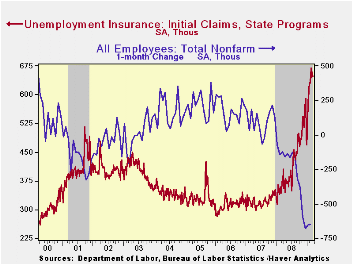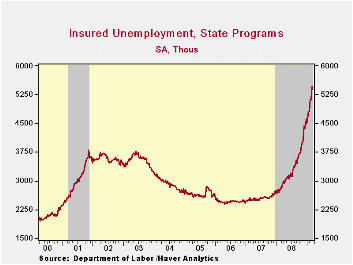 Global| Mar 19 2009
Global| Mar 19 2009U.S. Continuing Claims for Unemployment Insurance Touch New Record; Initial Claims Dip
by:Tom Moeller
|in:Economy in Brief
Summary
The latest figures from the Labor Department continue to indicate extreme weakness in the labor market. Continuing claims for unemployment insurance reached another record. At 5,473,000, the level of continuing claims in the latest [...]

The latest figures from the Labor Department continue to indicate extreme weakness in the labor market. Continuing claims for unemployment insurance reached another record. At 5,473,000, the level of continuing claims in the latest week remained nearly double that of last March. The series dates back to 1966. The four-week average of continuing claims jumped 118,800 to 5,251,250. Continuing claims provide some indication of workers' ability to find employment and they lag the initial claims figures by one week.
The figures on initial claims may indicate improvement in the picture of the labor market, but at this point, it's very tentative. First time claims for unemployment insurance reversed the prior week's upwardly revised gain and claims have been stable for a few weeks. The 12,000 decline in the latest period to 646,000, nevertheless, still left them near their highest level since 1982.
The latest initial claims figures include the survey period for March nonfarm payroll employment. There was a 15,000 (2.4%) increase in claims from the February period. During the last ten years there has been an 85% (negative) correlation between the level of claims and the month-to-month change in nonfarm payroll employment.
BLS indicated that the largest increases in initial claims for the week ending March 7 were in Indiana (+5,603), Pennsylvania (+4,702), Texas (+4,007), Florida (+3,894), and Michigan (+2,276), while the largest decreases were in New York (-11,218), Connecticut (-2,254), Tennessee (-2,153), California (-1,277), and Oregon (-1,139).
Though the latest level of continuing claims was a record, the labor force has grown as well, by nearly 30% over the last twenty years. Therefore, the insured rate of unemployment is not at a record high. It rose to 4.1% which was the highest since June of 1983. During the last ten years there has been a 93% correlation between the level of the insured unemployment rate and the overall rate of unemployment published by the Bureau of Labor Statistics. The highest insured unemployment rates in the week ending February 28 were in Michigan (8.0 percent), Oregon (7.7), Idaho (7.3), Wisconsin (6.9), Pennsylvania (6.8), Puerto Rico (6.6), Rhode Island (6.4), Nevada (6.2), Montana (6.1), and Alaska (6.0).
The unemployment insurance claim data is available in Haver's WEEKLY database.
More Money: Understanding Recent Changes in the Monetary Base from the Federal Reserve Bank of St. Louis is available here.
| Unemployment Insurance (000s) | 03/14/09 | 03/07/09 | 02/28/09 | Y/Y | 2008 | 2007 | 2006 |
|---|---|---|---|---|---|---|---|
| Initial Claims | 646 | 658 | 645 | 72.3% | 420 | 321 | 313 |
| Continuing Claims | -- | 5,473 | 5,288 | 91.0% | 3,342 | 2,552 | 2,459 |
Tom Moeller
AuthorMore in Author Profile »Prior to joining Haver Analytics in 2000, Mr. Moeller worked as the Economist at Chancellor Capital Management from 1985 to 1999. There, he developed comprehensive economic forecasts and interpreted economic data for equity and fixed income portfolio managers. Also at Chancellor, Mr. Moeller worked as an equity analyst and was responsible for researching and rating companies in the economically sensitive automobile and housing industries for investment in Chancellor’s equity portfolio. Prior to joining Chancellor, Mr. Moeller was an Economist at Citibank from 1979 to 1984. He also analyzed pricing behavior in the metals industry for the Council on Wage and Price Stability in Washington, D.C. In 1999, Mr. Moeller received the award for most accurate forecast from the Forecasters' Club of New York. From 1990 to 1992 he was President of the New York Association for Business Economists. Mr. Moeller earned an M.B.A. in Finance from Fordham University, where he graduated in 1987. He holds a Bachelor of Arts in Economics from George Washington University.






